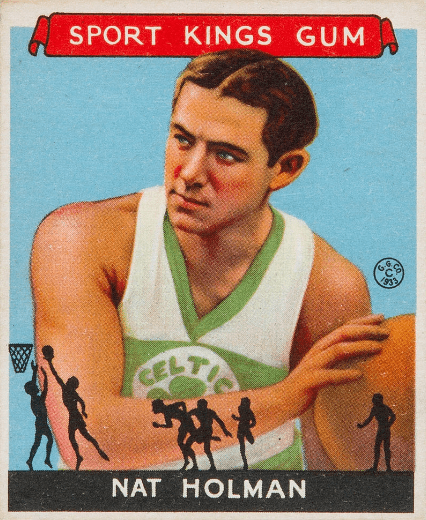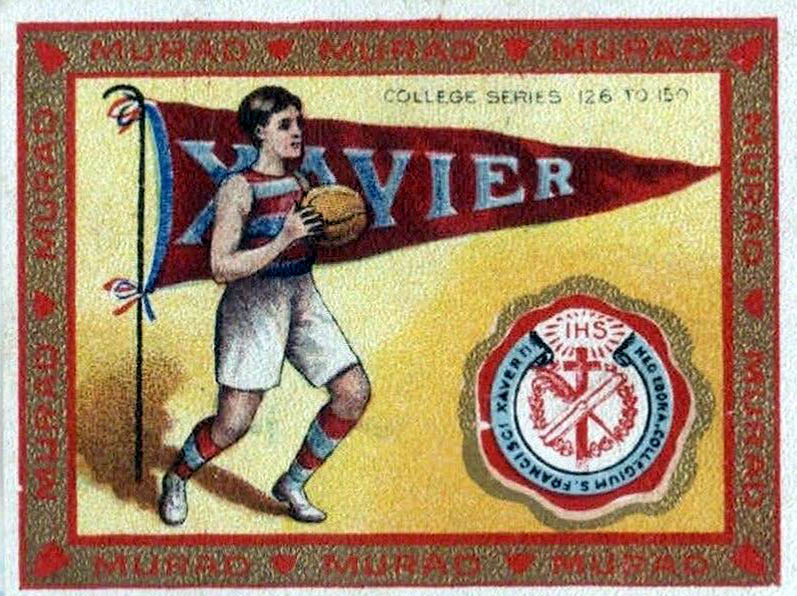The history of basketball cards is as interesting as the history of basketball itself. Not many people are aware that the first set of basketball cards was issued in 1948, years after the formation of the first professional league formed in 1898. However, later down the road, the history of basketball cards took a different path than basketball. Therefore, let us go back in history and see how it all started.
Pre-War Basketball Card Issues
The game of basketball was invented in 1891 by Dr. James Naismith and the first professional basketball league was launched in 1898. However, it was quickly abandoned in 1904. Additionally, the American Basketball League was established in 1925 and lasted until 1955. It was a serious attempt to develop basketball as a professional sport even though it underwent some serious complications and difficulties.
At the same time, most of the professional basketball games were being played in American colleges. This was the time when NCAA came into being along with NCAA Men’s basketball tournament in 1939. At the time, the game did not feature specific sets until 1948 when Bowman was released.
The 1909-1911 T51 Murad Set was the first note issue, which was college-based multi-sport. Amongst the 150 card sets, four are college basketball cards. According to many, the Murad cards tend to be the first-ever basketball cards in the history of the sport.
Then, in 1933, the next pre-war basketball issue was introduced, which was the Goudey Sports Kings multi-sport set. The set contains four notable cards including Joseph Lopchick, Ed Watcher, Nat Holman, and Eddie Burke. All of them except the Burke have been inducted into the hall of fame.
Although Wachter, Holman, and Lopchick made significant contributions to the game but most of the fans have hardly heard their names. For instance, Wachter is credited for inventing the bounce pass. Furthermore, the Goudey Sport Kings Basketball Cards were surprisingly cheap. In addition to that, they were also the most under-rated cards.
Just like football, basketball cards also went through their development phases and with new players jumping into the scene, the popularity was only destined to rise.
Basketball Cards-The Early Years
The year 1948 saw the release of the first official basketball, with the introduction of the 1948 Bowman Basketball Set. However, this was the first and only issue of Bowman. The set was popular amongst the collectors or the kids at the time and its popularity would further rise in the future.
The 1948 Bowman Basketball set is George Mikan. Mikan is remembered as the first superstar of the NBA and notably the league’s first official big man. Standing at 6’10” and weighing 245 pounds, Mikan was the ultimate dominant and managed to win seven championships along with three scoring titles.
Mikan’s 48 Bowman is arguably and easily the most valuable in the set, which can fetch around $1500 if in good condition.
Topps Joins The Fray
Topps in 1957, issued their first basketball issue. This was also the first time that Topps produce cards for all four major sports. The 1957 Topps set features 80 cards and is the most widely available.
The set’s highlight is the Bill Russell card that is considered his rookie card. It should be noted that the PSA has graded over 600 Russell rookie cards and if found in good condition, can fetch somewhere around $1000.
The set also includes the rookie cards of Tommy Heinsohn and Legend Bob Cousy. However, it would be comparatively hard to find the cards in good condition since the printing quality at the time was sloppy. Therefore, you will mostly come across cards that are grainy and contain print defects.
It’s Fleer’s Turn
Following Tropps, Fleer would now become the third country to take a shot at introducing a national basketball issue in 1961. However, this would be the first and last basketball issue of Fleer. Later, they returned with the 1968 landmark Fleer set.
If you have ever come across the 1961 Fleer set, you would instantly fall in love with its design. The set features and is loaded with rookie cards based on some of the best basketball players of all time including, Jerry West, Elgin Baylor, and Oscar Robertson. The 66 card set also contains 22 In-Action cards that are relatively sold at a lesser value than the traditional cards.
Moreover, the 1961 Wilt Chamberlain’s Fleer Rookie card is considered the most valuable basketball card of all time and a cornerstone vintage basketball card as well. If one is able to find it in good condition, the value sticks to around $700.
The Topps Monopoly: 1968-1981
In 1968, Topps launched a “Test Issue”, which many collectors are not familiar with. Even to this day, no one knows the issue’s origin but some believe that it wasn’t meant for distribution. It might be that an employee might have released it since the company did not have any plans of producing or marketing them.
Furthermore, the cards are quite rare as well. The PSA amongst the 22 card set had graded only 180 cards. The Bill Russell and Wilt Chamberlain cards were the most sought after.
1969-70 Topps Lew Alcindor
Lew Alcindor was not only one of the greatest of all time but the most feared big man as well. He was known for his towering sky-hook pushing back his opponents in fear. As a result, he enjoyed an illustrious career having won six NBA championships, 19 all-star selections, and six MVP awards.
Although his 69 Topps rookie isn’t rare since PSA nearly graded 3000 cards but some vintage basketball cards such as the Alcindor rookie of late can still fetch a few thousand dollars.
1970-71 Topps-Pete Maravich
Peter Maravich or Pistol Pete is credited for opening up the game in the 1970s. He was known for his creative ball-handling and entertaining passes, cementing his name in the history books. The 1970 Topps cards featured the continued oversized format with Maravich posing as a recent draftee. Similar to most top Topp issues, the Maravich card is also not rare but a good condition copy can carry a price tag of around $600.
1972-72 Topps-Julius Erving
Julius ‘DR J’ Erving is known as one of the most iconic players in the history of basketball. He was also one of the most impressive and graceful players of his time. According to many historians and basketball fanatics, Julius Erving resembled the first Michael Jordan but he was a unique player on his own and his records are close to being matchless.
Julius Erving played a huge role in popularizing the game and helped later legends make their way into basketball. During his career, Erving won four MVP awards and was selected to 16 All-Star games. His 1972 Topps rookie is easy to find. However, if you are looking for a good copy, you can find one with a price tag of $700 but if you want one in excellent condition. It can set you about $1600.
1974-75 Topps-Bill Walton
Bill Walton before entering the world of basketball was a basketball broadcaster. He was a force to be reckoned with and played well in both college and NBA. While he was with the Blazers he managed to win two titles and the same with the Celtics. However, his career was cut short due to injuries but always fun to watch.
His 1974 Topps card features Walton in a dazed pose. It is an iconic card, the mint copies of which are hard to find.
1980-81 Topps- Larry Bird/Magic Johnson
Topps in 1980 hit the spot by coming up with an oddball three-panel set featuring two of the most legendary and iconic basketball stars, Larry Bird and Magic Johnson. Both Bird and Magic helped bring the sport to the masses and went on to build mammoth careers.
The Bird/Magic rookie card is the most unique and special card there is. You don’t get to see so much history on one card, ever. PSA has graded nearly 10,000 copies, which makes it an easy find. However, find one in excellent condition and you are up for paying $3000.
The Most Valuable Basketball Cards
Some cards are more expensive than others and can be easily priced for five to six-figure price levels. For some players, collectors simply go crazy. One of the reasons for their popularity can be their scarcity, which often leads to fierce auction bidding competition leading to people bidding absurd amounts for a single card. Here are some of the most valuable basketball cards in history.
1948 Bowman #69 George Mikan
Because of Mikan’s excellent playing skills, George Mikan’s 1948 Bowman rookie card is considered a Holy Grail of all basketball cards. He played as the center and was a force to be reckoned with. The card has an unforgettable image, showing head-charging Mikan on a dark blue background.
Centring and edge toning are common challenges that you may face with this card. A while ago, several uncut sheets of this card also surfaced.
1957 Topps #77 Bill Russell
Collecting the 1957 Topps basketball card set is perhaps the most challenging task because they are rare. Poor centring and low printing quality make the Bill Russell card particularly hard to find. Russell is one of basketball’s most successful and dominant names, which is why collectors go crazy over this specific rookie card.
1986 Fleer #57 Michael Jordan
The 1986 Fleer’s Micheal Jordan rookie card is one of the most sought-after basketball cards due to Jordan’s skills and heroics on the basketball court. If Jordan was playing in a game, it was unlikely that anyone averaged more than Jordan’s 30.12 points, which makes him the most feared offensive weapon in basketball history.
1969 Topps #25 Lew Alcindor (Kareem Abdul-Jabbar) Rookie Card
When Kareem Abdul-Jabbar became the all-time NBA leading scorer, he debuted his mainstream basketball card in the 1969 Topps set. These cards were larger than the typical sports cards, and the design was highly creative, making them more susceptible to wear and tear.
Final Word
The year 1986 saw the rebirth of basketball and Fleer creating its landmark set. It was a time when the sport started gaining more attention from the fans but it was not until Michael Jordan stepped in. It totally changed the course of the game. However, the mass production of basketball cards also gave birth to counterfeits and frauds, which brought the overall demand significantly down in the 90s.




